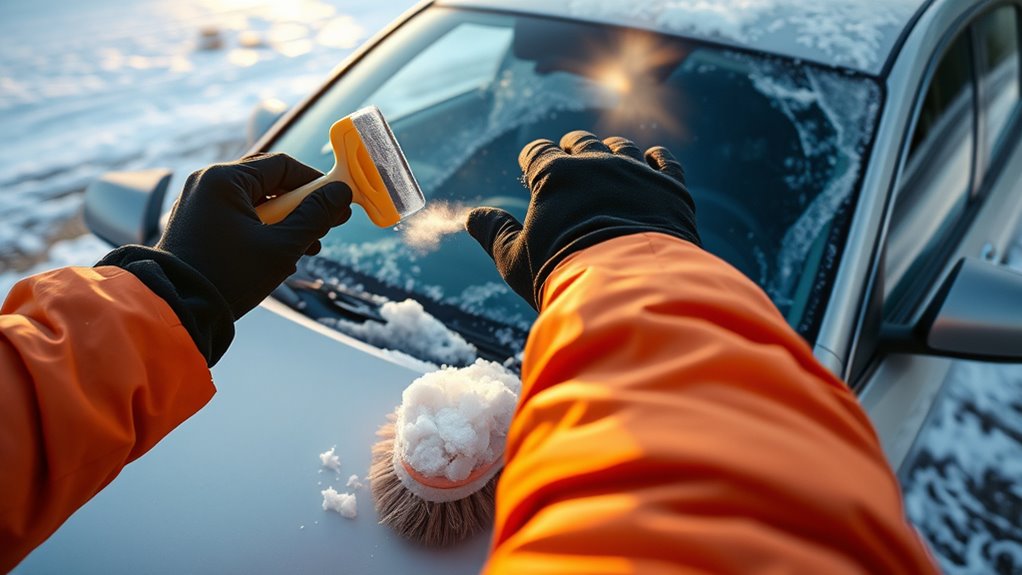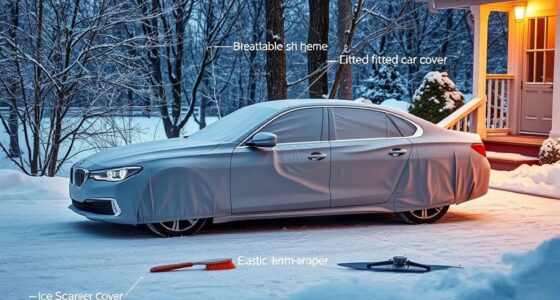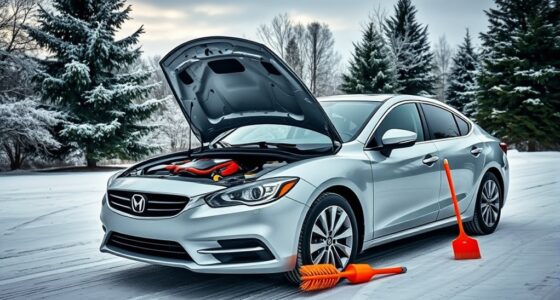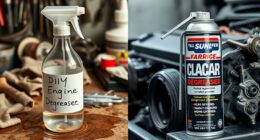To safely remove snow and ice from your car, gather the right tools like an ice scraper, snow brush, and de-icing spray. Warm up your engine first and use the defroster to loosen ice. Use gentle, controlled strokes with a flat-bladed scraper, starting from the edges inward, and avoid metal objects that can scratch your glass. Clearing all ice and snow properly helps make certain of safe visibility and protects your vehicle—continue to explore tips for smooth de-icing every winter.
Key Takeaways
- Gather essential de-icing tools like ice scrapers, snow brushes, and de-icing spray before starting.
- Warm the engine and use the vehicle’s defroster to loosen ice and melt snow effectively.
- Use a flat-bladed ice scraper with gentle, controlled strokes, starting from the edges inward.
- Avoid metal tools; opt for plastic or soft materials to prevent scratching or damaging glass.
- Clear snow from the roof, hood, and trunk to prevent falling ice and ensure safe driving visibility.

Have you ever struggled to clear ice from your car before heading out in the morning? If so, you’re not alone. Many drivers face this frustrating task during the winter months. The key to making it easier and safer lies in using the right winter accessories and mastering effective ice scraper techniques. Before you even start, gather your supplies—an ice scraper, a snow brush, and perhaps a de-icing spray. These tools are essential, especially when battling stubborn ice layers. Good winter accessories are designed to handle cold temperatures and tough ice, making your job much simpler. An ice scraper with a sturdy, flat blade will help you chip away at the ice without damaging your windows, while a snow brush with a soft bristle side can clear snow from your windshield and hood. Keep in mind that using the correct tools prevents scratches and guarantees you won’t accidentally crack or break your glass.
When it’s time to de-ice, start by warming your engine for a few minutes. This will slightly heat the glass from the inside, loosening the ice. Once the engine is warm, turn on your defroster to help melt the ice further. Applying a de-icing spray directly onto the icy surface can also speed up the process. Spray liberally over the frozen areas and wait a minute or two for it to work. This simple step reduces the physical effort needed to scrape away the ice, and it minimizes the risk of damaging your glass or paint. When using your ice scraper, hold it firmly and use controlled, deliberate strokes. Avoid pressing too hard, as that can crack the glass or cause scratches. Instead, use a combination of gentle scraping and letting the tool do the work. Start from the edges and work your way inward, ensuring you clear all the ice from the entire window and mirror surfaces. Proper tool selection is crucial for avoiding damage and making the de-icing process more efficient.
It’s essential to remember that you should never use metal objects like knives or screwdrivers to remove ice. They can easily scratch or crack your windows and are unsafe. Keep your ice scraper handy and always use the proper technique. Don’t forget to clear the snow off your roof, hood, and trunk to prevent ice from falling onto your windshield while driving. Taking your time with these steps ensures a safer drive and reduces wear on your vehicle’s glass. By investing in the right winter accessories and applying effective ice scraper techniques, you’ll make your mornings less stressful and your winter driving safer. Proper preparation and careful effort go a long way in dealing with ice, keeping your car clear and your visibility perfect.
Frequently Asked Questions
Can Using Hot Water Damage My Car’s Paint or Glass?
Using hot water on your car might seem effective, but it carries hot water risks like paint damage and glass cracking. Hot water can cause paint to warp or peel, especially if it’s already chipped or fragile. Instead, use lukewarm water or a dedicated ice scraper. This way, you avoid the dangers of hot water risks and protect your car’s paint and glass from potential damage.
Is It Safe to Use Household Chemicals for De-Icing?
You might worry about using household chemicals for de-icing, but many are safe if used properly. For example, a mixture of salt and water can help melt ice without damaging your car’s paint or glass. Just avoid harsh chemicals like bleach or ammonia. Always follow instructions for de-icing safety, and don’t overuse chemicals—this keeps your car safe and avoids unnecessary corrosion or damage.
How Can I Prevent Ice Buildup on My Windshield?
To prevent ice buildup on your windshield, you should regularly use a good quality windshield washer fluid that resists freezing. Additionally, invest in a windshield cover to block snow and ice from settling directly on your glass. Before a storm, apply the cover and top off your washer fluid. These steps help keep your windshield clear and make de-icing easier, saving you time and effort in harsh weather.
What Are the Best Tools for Efficient Snow Removal?
A stitch in time saves nine, and that’s true for snow removal too. To clear your car efficiently, invest in reliable snow removal tools like a sturdy snow brush and an ice scraper. Opt for ice scraper options with a sturdy handle and a durable blade, making it easier to break ice without scratching your windshield. These tools help you work quickly and safely, saving you time and effort on cold mornings.
Should I Warm up My Engine Before De-Icing?
You should warm up your engine before de-icing because it helps improve engine warm-up and guarantees better battery health. By letting your engine run for a few minutes, you allow the antifreeze to circulate and the heater to work efficiently, making de-icing easier. Just avoid idling too long to save fuel and reduce emissions. A properly warmed engine also prevents strain on your battery during cold mornings.
Conclusion
Now that you know how to safely remove snow and ice, you’re armed with the tools to face winter’s icy grip. Think of your car as a precious gem, shimmering beneath a frosty cloak—carefully revealing its sparkle. With patience and the right techniques, you’ll protect your vehicle and guarantee a smooth start to each day. Embrace these steps as your shield against winter’s chill, turning icy obstacles into moments of confident control.









